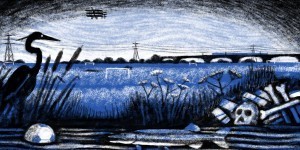Gareth E. Rees's Blog, page 6
October 23, 2013
A Dream of Flight Over Walthamstow Marsh
In 1909 a man built a wooden aeroplane, and rolled it onto Walthamstow Marsh…
Here is ‘Flight’, from an album I’ve made with Jetsam called A Dream Life of Hackney Marshes. The track is about the first British manned flight, which took place on Walthamstow Marsh in 1909. I’ve written my own lopsided version of the historical event here.
The album is an exploration of the Lea Marshes, incorporating chamber music, electronics, spoken word, avant rock and field recordings. It’s based on my short story about
a man who begins a torrid affair with an electricity pylon in the Middlesex filter beds, which appears in the anthology Acquired for Development By… (Influx Press, 2012)
Click here to read Acquired for Development By…
The full album will be released on the Clay Pipe Music label in November. (The beautiful artwork you can see on this page is by Clay Pipe’s Frances Castle). But if you’d like to hear me and the band perform A Dream Life of Hackney Marshes live, join us for an evening of music, film and spoken word on Wednesday 6th November. As well as a live performance of our album, there will be short films, guest performances from Kadialy Kouyate and Kora Kareem Brown, plus DJing by the excellent Liminal Londoner.
Event details:
A Dream Life of Hackney Marshes
Wednesday 6th November @ Ye Olde Rose & Crown, 53 Hoe Street, E17 4SA
Doors 7pm.
You can order tickets here: tickets
September 21, 2013
How I Ruined Hackney (& the Mystery of “The Hackney Slap”)
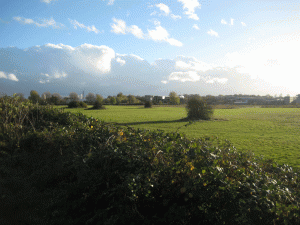 On a bright afternoon I was on Walthamstow marsh with my dog Hendrix, walking beneath the brow of the old aqueduct path where the brambles grow. He was coming the other way, a stocky man, late 40s, with a collie.
On a bright afternoon I was on Walthamstow marsh with my dog Hendrix, walking beneath the brow of the old aqueduct path where the brambles grow. He was coming the other way, a stocky man, late 40s, with a collie.
“Watch out for her!” he said, pointing at his dog, “She’s on heat.”
“Oh, don’t worry,” I said, “he’s been done.”
The man’s head began swinging angrily from side to side. He held onto his thoughts for a few paces then blurted: “Why the hell would you want to do that? Why? Why? Why would anyone do that to a dog? You’ve ruined his life! Why take away his manhood? YOU ARE IN THE POCKET OF THE VET!”
Hendrix, poor sod, was castrated because he was born with a serious eye-defect. It was unethical to allow him to pass on his genes. But really it was none of this man’s business.
“It’s none of your business,” I said, as we crossed paths.
The man’s face darkened. By now he was walking backwards away from me, and I walking backwards away from him.
“You… you… you lot have ruined Hackney,” he cried “RUINED IT!” As he spoke, the spittle of his wrath caught the sunlight and formed a rainbow. “Because of YOU I have to move away. You fucking ponce! …Newbie!”
“I’ve been here a decade,” I said, still walking backwards.
“A decade?” Although there was growing distance between us, I could see his face flush with rage. “God, yeah, right, oooh, a decade, yeah, good one, you total arsehole.”
At this point, somewhat unwisely, I raised my middle finger.
Now he stopped walking backwards and stood facing me, head slightly bowed, like a bull about to charge. It was at this point I realised…there was a good chance I was about to get beaten up on the marshes on a sunny afternoon.
Another eruption of violence
from the hole in London’s time…
What was really strange was that I’d just finished writing a book called Marshland in which one of my characters – an embittered Victorian filter bed worker – ends up having the exact same experience when he (for extremely peculiar reasons) ends up on Hackney Marsh in the year 2013 during a league football afternoon.
My book - a psychedelic brew of local legend, strange walks and supernatural fiction – posits the marshes as a hole in London in which time eddies, bringing together the disparate events of the marsh’s past, present and future in a kaleidoscopic swirl…
Viking raids up the Lea river… Dirk Turpin’s antics at his watering hole on Hackney marsh… Victorian rebellions against the water and rail companies who wanted to seize their land… Blitz bombs… anti-aircraft guns… sightings of phantom bears and goose-murdering crocodiles…midnight raves…dogging and cottaging… Olympic protests… land-grabs by insatiable developers.
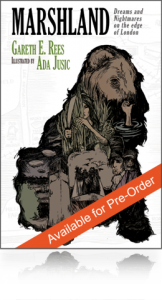 The book begins with a strange (entirely true) incident in which I am lowered upside down into the Lea river by a complete stranger…
The book begins with a strange (entirely true) incident in which I am lowered upside down into the Lea river by a complete stranger…
So what an amazing ending this would be… beaten to a glorious, bloody pulp on the marshes I’d obsessed over for years… my blood running into the earth… my own story ending in these hallowed water ditches.
Finally, after a lifetime of feeling like a visitor wherever I lived, I’d belong somewhere.
Imagine the posthumous book sales!
Maybe they’d even give me a plaque:
Gareth Rees, writer, died here.
He ruined Hackney.
Truth be told, we weren’t even in Hackney. This was Walthamstow. My potential killer had some valid points about gentrification but didn’t appear to be fully aware of the geography of the place in which he was about to commit murder. That said, I doubt he was bothered by the finer details of borough boundaries. If I pointed them out now it would probably make things worse.
I considered running, but didn’t bother. I held my ground and waited for him to make his move.
“Next time I see you,” he yelled. “I’m gonna give you a Hackney slap!”
Then he turned away and headed towards Leyton marsh.
A Hackney Slap?
I was quite excited by this. I’d not heard of a Hackney Slap. I wondered what it would entail. When I got home and googled it, I found nothing. There’s a dubstep instrumental called ‘Hackney Slap’. That’s it.
Shame really. It has a nice ring to it.
If you’d like to pre-order a copy of Marshland: Dreams & Nightmares On the Edge of London, then click here. It’s available with a 25% discount until the 25th October. The first 100 copies will be signed by me and the illustrator Ada Jusic.
May 7, 2013
Oh No, it’s Another Lea Marshes Spandex Pylon Raveorgy!
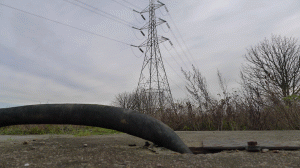 It began just before dusk with the sound of cracking concrete behind Walthamstow marsh.
It began just before dusk with the sound of cracking concrete behind Walthamstow marsh.
The horses in the Lee Riding Centre whinnied in panic. A kestrel wheeled away from its hunt and shot across the skyline to the Essex filter beds. Two men behind the reservoir hurried out from under cover, hurriedly pulling up their pants.
As the cracking got louder, leathery tubes began to snake from concrete plinths at the feet of pylons, slithering through the scrub and plugging into sockets concealed in boggy sinkholes, wherein lay the ancient soundsystems of Marshlanta, a lost analogue tribe.
There was a cacophonous clatter as the tubes plugged themselves in. Then music began to play.
“GIVE ME MY MIND BACK”, boomed one of the pylons, gyrating wildly, wrenching free from its cables. From Hackney Marsh to Enfield, the others followed suit. Soon the pylons were free to pull on Spandex mini-skirts and tight leather pants. They began to strut up and down the old aqueduct path while herons, gulls, parakeets and crows flocked in spirals around them.
As the beats accelerated, some of the pylons bowed down to snort gravel from the freight train lines. Others sucked from the giant gas cylinders overlooking the industrial estate. What a buzz! The disco had well and truly begun.
The good vibes vanished quickly when sinister human ravers emerged from the marshes, carrying stockpiles of ketamine, acid and Roflcopter. The ravers may have been tiny spindles of flesh, but the giant pylons were in over their heads.
Famously, pylons are unsuited to human drugs. Soon they were are in a sorry state, swimming in the reservoirs (instantly electrocuting thousands of cormorants), copping off with telegraph poles, dry humping the Lee Valley Ice Centre and enthusiastically making plans to set up electronic bookshop/bars in South America. The gibberish intensified and the drainage ditches around the marsh quickly filled with fluorescent electro puke as, one-by-one the great pylons toppled.
Meanwhile in London, the lights went out…
Below is a rare recording of the music played that night.
March 7, 2013
Through the Walthamstow Rabbit Hole
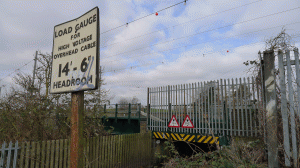 The Rabbit Hole is at the north corner of Walthamstow marsh, where the reservoirs and railway lines converge at a five foot bridge.
The Rabbit Hole is at the north corner of Walthamstow marsh, where the reservoirs and railway lines converge at a five foot bridge.
The entrance is a dark letterbox which threatens to collapse with the weight of the world above it. But for those unable to observe this, a triangle sign warns 5’0″ and another helpfully translates this into the metric system: 1.5 metres.
On a slope above the entrance a red sign warns: Stop, Look, Listen, Beware of Trains. Another explains the load gauge for the high voltage overhead power lines. These lines are festooned with little discs, wire loops and orange balls, like lights on the seafront of a decayed British seaside town. A Blackpool Tower pylon looms over the scene.
After walking ancient marshland, where plunge pools lurk within the bog, cows ambush you, and abandoned campfires smoke in the undergrowth, the barrage of health and safety information comes as a shock. These messages demand you look at them, read them, pay heed to the multiple hazards and grizzly outcomes that may befall you.
Crushed, electrocuted, severed, slashed, eviscerated, decapitated – watch out!
If you absolutely must leave the marsh and pass through here, says the unknown sign writer, then you should at least know what you’re getting into: through the rabbit hole lies the engine room of London’s spectacle, where pipes, pumps and humming electricity exchanges are strewn between networks of deadly deep water.
This is a place at the edge of the city, at the brink of life itself, where death is only ever a fence away.
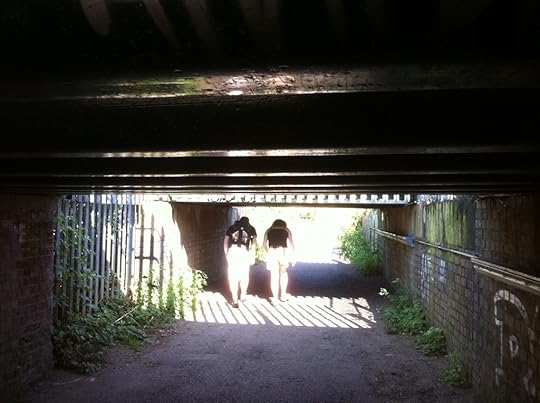 The 5ft bridge is the first warning of the change to come. As in Alice’s Adventure, this Rabbit Hole demands you shrink yourself before your passage.
The 5ft bridge is the first warning of the change to come. As in Alice’s Adventure, this Rabbit Hole demands you shrink yourself before your passage.
Inside the bridge, glimmering walls are streaked blue, green and yellow. Sunshine streaks through a gap between the railway lines, creating a luminescent membrane through which travellers pass as if entering into the kingdom of God or the doorway of a Spielbergian space ship.
In the central shaft of light I stand upright, push my head between the two railway lines and laugh into the wheels of the train screaming from Stratford to Tottenham Hale.
That was a tiny fragment-in-progress from my forthcoming book for Influx Press, to be published later this year. I’ll post more news soon. Or sign up to my Marsh News email thing and I’ll make sure you’re first to know!
January 15, 2013
Red Night – A Soundchronicity Walk on Hackney Marsh
 Soundchronicities are those moments where the music you are listening to fuses with your environment, creating powerful impressions.
Soundchronicities are those moments where the music you are listening to fuses with your environment, creating powerful impressions.
F or my latest experiment I listened to TVO’s Red Night while walking a ciruit around Hackney Marsh, from the Old River Lea to the Lea Bridge Road. This is an edited version of my notes.
TRACK 1. Red Night begins with a barely audible hiss, no louder than London’s perma-drone: traffic, distant drilling, the pulse of planes. The stripped banks of the Old Lea River are haunted by the railway power lines and warehouses beyond.
TRACK 2. 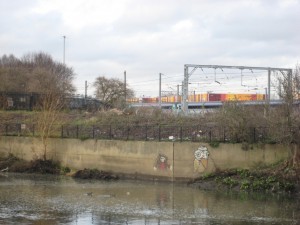 The river runs with the drone of ‘Tamaghis’. A concrete ledge is draped with root tendrils. A black poplar splayed like a charred star fish. A photographer with a tripod stalks through the dead leaves. This track creeps up on you, ever more intense, until Hackney drowns in white noise. The banks brim with rubbish. The natural order is defeated. The Lea is alive instead with trans-human sound. A bastard fusion of man and machine. Forklifts crunch through pallets. In the future these things carry on without us. Machines feed on our leftover energy. Electricity dribbles from snapped power-lines. An eternal loop of pop music crackles from a radio. The DJ is a corpse with his cranium slumped on the play button.
The river runs with the drone of ‘Tamaghis’. A concrete ledge is draped with root tendrils. A black poplar splayed like a charred star fish. A photographer with a tripod stalks through the dead leaves. This track creeps up on you, ever more intense, until Hackney drowns in white noise. The banks brim with rubbish. The natural order is defeated. The Lea is alive instead with trans-human sound. A bastard fusion of man and machine. Forklifts crunch through pallets. In the future these things carry on without us. Machines feed on our leftover energy. Electricity dribbles from snapped power-lines. An eternal loop of pop music crackles from a radio. The DJ is a corpse with his cranium slumped on the play button.
TRACK 3. “Ba’dan”, a wash of aquatic bubbling and static crunch. A digger claws through broken boxes. The reverse lights of a truck in New Spitalfields Market flash to the beat. Everything is sucked downriver in a weary funk. The East Marsh, post-Olympics, is a burial mound of soil. No birds sing. The artificial bird song at the end of Ba’dan replaces what is missing. I hear a squeaky wheel. I take off the headphones. It’s not from the track – it’s some kind of bird or a broken trolley in New Spitalfields. I don’t know. I have lost the distinction between the natural and the synthetic.
TRACK 4. Nobody is walking on Hackney Marsh. Only a line painter van doing angular circuits in an icy wind. The relentless clicks of ‘Yass Wadda’. I am frozen out of my own thoughts.
TRACK 5. The robotic techno of ‘Waghdas’ begins its march as two helicopters chase each other across the sky. The track is powered by a whirring fan generator. Loud bass pulses. I turn up the volume as I stride across the football pitches. A man comes towards me, pushing a white line painting machine. He is one of Hackney’s Nazca men, delineating the post-human desert. A priest representing the old religion of manual labour.
TRACK 7. 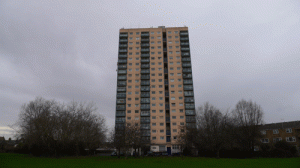 I walk along the eastern flank of Hackney marsh and stand before the Headquarters of the Kingdom of God, listening to ‘Naufauna’. The tower block looms over stripped trees. Disembodied voices echo rhythmically over fragmented drums. After the desolation walking beside the Lea, it feels like post-apocalyptic tribes are returning to the wastelands of Hackney.
I walk along the eastern flank of Hackney marsh and stand before the Headquarters of the Kingdom of God, listening to ‘Naufauna’. The tower block looms over stripped trees. Disembodied voices echo rhythmically over fragmented drums. After the desolation walking beside the Lea, it feels like post-apocalyptic tribes are returning to the wastelands of Hackney.
TRACK 9. ‘Ghadis’ begins with motorbike revs, or the sawing of trees. The red wall of the ruined coal power station broods over a recycling plant. The machines are alive. Everything masticated, murdered, made anew. The track grows in power. Steam escapes through vents. I am marching to the beat.
TRACK 10.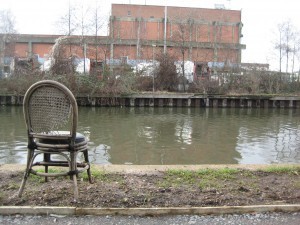 I listen to ‘B-23’ by the canal approaching the Lea Bridge Road. A white teenager in a Kaftan frantically scoops rubbish from the verge and hurls it onto the path. He speaks to me. But in my ears William Burroughs is speaking. It’s as if the teenager has the voice of Burroughs. He tells the tale from the novel Cities of the Red Night of the sick, blotched boy presented to the doctor. Sexual delirium, says the doctor, send him to isolation. Humankind is the epidemic. When we are gone, only the line painters will remain. Self driving forklifts will crash through pallets, trash the remaining stock. Everything must go.
I listen to ‘B-23’ by the canal approaching the Lea Bridge Road. A white teenager in a Kaftan frantically scoops rubbish from the verge and hurls it onto the path. He speaks to me. But in my ears William Burroughs is speaking. It’s as if the teenager has the voice of Burroughs. He tells the tale from the novel Cities of the Red Night of the sick, blotched boy presented to the doctor. Sexual delirium, says the doctor, send him to isolation. Humankind is the epidemic. When we are gone, only the line painters will remain. Self driving forklifts will crash through pallets, trash the remaining stock. Everything must go.
For more Soundchronicity Experiments – including Jon Brooks, Ekoplekz and The Psychogeographical Commission – take a look at this: Soundchronicities
Buy TVO’s Red Night here
Or listen to a sample with amazing visuals by Erstlaub….
October 16, 2012
A Dream Life of Hackney Marshes: Music from the Marshes Live at the Union Chapel
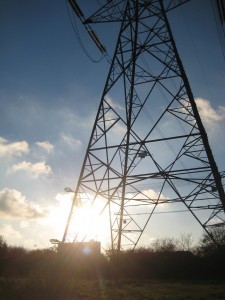 “There is a hole in London, which swallows up the city’s time….”
“There is a hole in London, which swallows up the city’s time….”
I’m hugely nervous and excited to announce that on Saturday 20th October I’ll be performing A Dream Life of Hackney Marshes at The Union Chapel, Islington with the 6-piece experimental contemporary music ensemble, Jetsam. This atmospheric musical suite is inspired by my short story of the same name and also pieces from book I’m writing for Influx Press due in 2013.
Combining music and spoken word, ‘A Dreamlife of Hackney Marshes’ is a hymn to Hackney and Walthamstow Marshes; a re-awakening of the old river Lea, a love song to a pylon; a bomb blast beneath the football pitches; an ode to a pigeon hideout; a meditation on the ruins of times gone by.
Jetsam’s score is dark, complex and uncompromising. It just begs to be heard in the incredible surroundings of the Union Chapel.
The performance is from 12-2pm. This is the debut outing for this piece, so it would be great to see you there and hear your thoughts.
For more information please go to: EVENT INFORMATION
Or check out the Facebook event page here: FACEBOOK
August 23, 2012
Rebel River: A Heroic History of the Lee
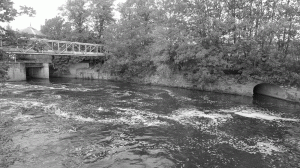 The Thames cuts a lonely swathe through maps of contemporary London. Looked at from above, she’s one of the last visible reminders of a landscape lost beneath sediments of concrete and steel. She trails sadly through the megalopolis like a party ribbon hanging from the back of a crashed wedding limousine.
The Thames cuts a lonely swathe through maps of contemporary London. Looked at from above, she’s one of the last visible reminders of a landscape lost beneath sediments of concrete and steel. She trails sadly through the megalopolis like a party ribbon hanging from the back of a crashed wedding limousine.
It wasn’t always this way. In the past the Thames enjoyed the company of many tributaries including the Fleet, the Effra, the Tyburn, the Westbourne, Walkbroook, Falconbrook, Stamford Brook and Counter’s Creek. These rivers have since been bricked up, turned into sewers, forced underground. Some occasionally struggle to the surface, reduced to the role of park streams, sluicing through concrete channels bearing a navy of crisp packets and fag butts, humiliated and subjugated by the city.
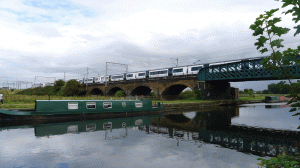 The 40 mile long Lee is one of the few waterways to stand firm against the insatiable city as it spreads east, consuming and regurgitating all in its path. She begins life in the Chiltern Hills at Leagrave, and flows South through Ware, Cheshunt, Waltham Abbey, Enfield Lock, Tottenham, Upper Clapton, past Walthamstow marsh, through Hackney marsh, Hackney Wick, Stratford, Bromley-by-Bow, Canning Town and finally Leamouth where she pours into the Thames.
The 40 mile long Lee is one of the few waterways to stand firm against the insatiable city as it spreads east, consuming and regurgitating all in its path. She begins life in the Chiltern Hills at Leagrave, and flows South through Ware, Cheshunt, Waltham Abbey, Enfield Lock, Tottenham, Upper Clapton, past Walthamstow marsh, through Hackney marsh, Hackney Wick, Stratford, Bromley-by-Bow, Canning Town and finally Leamouth where she pours into the Thames.
But the Lee has always been more than a river. She’s a historical border between Middlesex, Essex and Hertfordshire. Even further back in time she was the frontier between Saxon England and Danish Viking territory.
Lee & The Vikings
The Danish Vikings had established a foothold in East and North England in 865AD. They made regular raids on the Saxons, looting villages and stealing livestock. To keep the peace, King Alfred signed a treaty with King Guthrum agreeing a border “up on the Thames, and then up on the Lea, and along the Lea unto its source, then straight to Bedford, then up on the Ouse to Watling Street.”
This border became known as the Danelaw. The Saxons would stay to the South and West of the Lea. The Danes would keep to their path to the East.
But the Vikings were a notoriously restless bunch.
In 894AD the Lee was wide and fast-flowing enough for a fleet to sail as far as Ware in Hertfordshire, their ships adorned with images of dragons and banners bearing ravens, their crew hungry for pillage. Saxon legend has it that Alfred responded by draining lower reaches of the river, cutting off the water channel at Waltham and stranding the enemy. The Vikings scattered on foot and had to fight their way home.
This was the beginning of human meddling with the Lee. Over the centuries many more artificial channels have sapped the river’s strength and width. She’s been diverted through mills, forced through filter beds, hemmed into reservoirs and siphoned off by the heavy industry which came to dominate the valley.
In the 18th Century a process of canalisation began, creating a series of cuts and locks to aid the transportation of grain. Like a great whale at the mercy of hunters, harpooned with pick axes and shovels, the Lee has grown slower with every blow. Each new drainage channel is a slashed artery draining her lifeblood. Her wounds fill with silt and petroleum spilled from overloaded barges. Slower, slower she moves, her vision dimming until she’s flanked on both sides by concrete and can only dream of her tidal past while jubilant men in flat caps whistle and beckon over the loading hooks.
The Irrepressible River
In 1590 Edmund Spenser wrote in his poem The Faerie Queene of ‘the wanton Lee, that oft does loose his way”. By the end of the industrial revolution, the Lee had been forced into the servitude of London, her curvy lines straightened, her naturally wayward character repressed and conditioned by the demands of the metropolis.
But the Lee is an irrepressible river. She’s not like the others. She isn’t broken so easily.
The lower lea valley may have been industrialised and then gentrified, but the marshlands obey different laws. They’re conditioned by a slower, preternatural chronology. And it’s at the entrance to the marshlands, by the Lea Bridge Road, she begins a breathtaking comeback. At the tumultuous weir she splits away from the canal and cascades through Hackney Marshes.
From this point she is no longer the Lee. She’s the Lea. And she’s remembered herself.
July 10, 2012
Escape from London 2012: The Neo-Trekkers of Hackney & Walthamstow Marshes
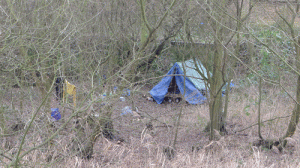 In Trekkers:Edgeland Renegades from London’s Lie-Dream I wrote about the people who ran away to Hackney marshes and Epping Forest to escape the Blitz bombing. In doing so, they were banished from the history of the war. But if you look closely, trekkers
still exist in today’s marshland.
In Trekkers:Edgeland Renegades from London’s Lie-Dream I wrote about the people who ran away to Hackney marshes and Epping Forest to escape the Blitz bombing. In doing so, they were banished from the history of the war. But if you look closely, trekkers
still exist in today’s marshland.
The tent appeared in February, near the back of one of the filter beds, nestled among the trees. At first I thought it was a discarded tarpaulin and passed by without much thought. In these parts you often stumble upon duvet covers, torn dresses and groundsheets. Once I found a silk curtain, elegantly draped like a toga on the branch of a tree in a thicket behind the railway lines.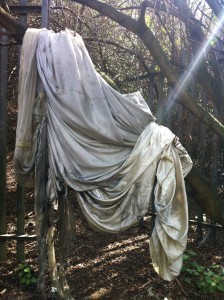
The next day I took a proper look. I could see that the tarpaulin formed a large tent. It had a raised wooden floor with shoes racked beneath. I dropped from the stone ramparts into the bed, clutching my camera. Something shifted in the darkness behind the flaps. I panicked and moved away.
What was it doing here?
Tents regularly appear in the marshes. Usually they’re small one-man deals concealed in the wilds of Walthamstow marsh. I imagine their occupants to be opportunists. An urban explorer. A vagabond preferring a sleep in the woods to another waking nightmare on the savage streets. Adulterers out for a sneaky fuck. Teenage mushroom voyagers on a trip.
But this enormous thing was right slap-bang in the filter beds, the only bit of this edgeland that comes close to being a tourist attraction.
It was admirably brazen.
The following day I saw a scattering of belongings outside the tent door. A water bottle. A small pile of wood. A hat on a stick. 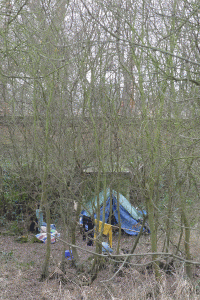 As days rolled by this detritus increased. Human junk started to spread across the filter bed. Now there was a clothes line, festooned with shirts, slung between two tree trunks. I saw a kettle, a scorched fireplace and suitcase on wheels, the sort businessmen drag through airports.
As days rolled by this detritus increased. Human junk started to spread across the filter bed. Now there was a clothes line, festooned with shirts, slung between two tree trunks. I saw a kettle, a scorched fireplace and suitcase on wheels, the sort businessmen drag through airports.
This went on for a good few weeks until the filter bed seemed properly occupied – and by just one couple. I finally saw them on the day they were kicked out. A couple in their late twenties yelled furiously at each other in what sounded like an Eastern European language as they plucked their belongings off the clothes line. In the stone plateau at the centre of the filter beds a Lea Valley ranger tapped his fingers on his vehicle, the engine humming.
Then they were gone.
I felt sad to see them go.
The secrets of the atemporal tent
There was something atemporal about that tent. It enmeshed London’s future, past and present in a single sheet of blue tarpaulin.
…It offered a vision of Hackney marshes after mainstream society has collapsed into civil war and anarchy – a time when refugees hide on the urban fringe, living off salvaged leftovers.
…It harked back to the Second World War, when trekkers camped here to escape the Luftwaffe bombers.
…It told of an epoch before the city when humans lived and hunted by the River Lea.
…It said something about how this place still attracts people who want to escape what’s expected of them.
And no wonder the lure of the marshlands is so strong. Once you cross the canal from Hackney, there are no more security cameras. No more advertising billboards. No synagogues, churches or mosques. No schools. No property. No rents. The state and its institutions lose their power here. Their communication lines are severed.
There’s a comforting anonymity to the network of paths, overgrown verges and boggy fields. The city exists here only in fragments. Bottles and cans. Syringes. Submerged cash machines. The red flash of a bus breaking cover on the road overhead. Broken slabs. A gurgle from a subterranean sewer.
You can piece together these fragments into your own narrative. Make of it what you will.
Here it’s possible to live – for a moment at least – liberated and re-invented.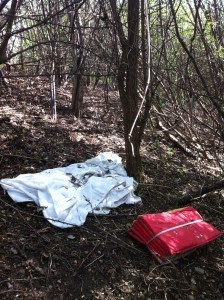
Men who aren’t allowed by their culture to shag other men come and shag other men. Ravers who aren’t allowed to play loud music and gather in public places gather here in large numbers and play loud music. Teenagers who aren’t allowed to do anything at all come here to smoke, to drink, to tell tall tales.
Alcoholics and junkies congregate in the undergrowth. A Hasid teen smokes a cigarette. A Turkish businessman heads off for some gay nookie with a lover. A young mum sups a can of lager.
These are London’s neo-trekkers, on the run from what’s expected of them in the grand narrative.
Instinct tells them that this is one of the few places where you can step outside the chronology of the city.
On this atemporal fringe of the city, you can wander ancient marshlands beneath a circling hawk and imagine the last hundred years never happened. You can imagine the present is nothing more than a fake, painted skyscraper backdrop on the skyline. You can stand on the ruins of a water filtration plant and imagine you’re a hundred years in the future and all that you know of is dead.
Suddenly it’ll hit you.
You don’t want to go home.
So you crawl beneath a bush. Pull a sheet of plastic over yourself. Open a bottle. Let the night shroud you in darkness.
You sit and watch the lights of the distant city rise like flames.
COMING SOON TO THE CHRONICLES… a conversation with a ghost.

